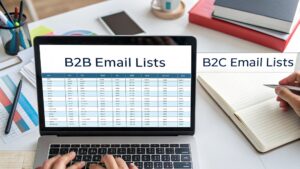Ever wonder how companies talk to their customers? They use email! But not all customers are the same. Some are other businesses. Some are everyday people. This is where B2B and B2C email lists come in. Understanding them is super important. It helps companies send the right messages. This means more sales and happy customers. Let’s explore these two types of lists. We’ll see how they are different. We’ll also learn why that matters.
Why Email Lists Are Super Important
Think of an email list like a special club. Only members get the news. For businesses, this club is full of potential buyers. Companies use these lists to share updates. They send special offers too. A good email list is a powerful tool. It helps businesses grow. It builds strong relationships with customers. Without one, reaching people is much harder.
B2B: Talking to Other Businesses
B2B stands for Business-to-Business. Imagine a company that makes special software. This software helps other companies manage their money. Their customers are not individuals. They are other businesses. So, their email list will have contact info for other companies. This might be a CEO’s email. It could be the head of a department. These emails are very specific. They are for people who make big company decisions.
B2B emails are usually formal. They focus on professional needs. They might talk about saving money. Or they could discuss making work easier. The goal is to show value to another business. These emails are often longer. They might include case studies. This proves the software works. Building a B2B list takes time. It needs careful research. Finding the right contacts is key. For instance, you wouldn’t send a personal discount. You’d offer a business solution.
How B2B Email Lists Are Built
Building a B2B email list is different. Companies often get emails from trade shows. They might get them from industry events. Sometimes, they use LinkedIn. This professional network is great for finding db to data business contacts. They might also get contacts from website sign-ups. These sign-ups are usually for whitepapers. Or they are for webinars. These resources offer business insights. They attract other professionals. Furthermore, businesses might partner. They share valuable contact information. This expands both of their reach.
What Goes Into B2B Emails
B2B emails are very precise. They offer clear solutions. The language is professional. It often uses industry terms. These emails focus on return on investment (ROI). They might explain how a product saves time. Or how it boosts efficiency. The call to action is direct. It could be to schedule a demo. Or to download a free guide. The goal is to move the business along. It’s about solving a problem for them. This creates a strong business connection.
Examples of B2B Email Content
Imagine an email about new accounting software. It highlights how it cuts costs. It explains how it reduces errors. Another email might offer a free trial. This trial is for a project management tool. It shows how it helps teams. These emails are never about personal enjoyment. They are always about business benefit. They aim to help the recipient’s company succeed. This builds trust among businesses.
B2C: Talking to Everyday People
B2C stands for Business-to-Consumer. Think about your favorite clothing store. They send emails about new arrivals. Or about sales events. Their customers are individuals like you and me. So, their email list has personal emails. These are for people buying things for themselves. These emails are often more casual. They use exciting language. They want to make you feel good.
B2C emails are usually about fun things. They might show new fashion trends. Or offer discounts on everyday items. The goal is to the tension between the interests of business encourage quick purchases. These emails are often shorter. They have catchy headlines. Building a B2C list is often faster. It uses website sign-ups. Or social media promotions. For example, a restaurant might send daily specials. They want you to come in for dinner.
How B2C Email Lists Are Built
Building a B2C email list is often simpler. People sign up for newsletters. They do this on e-commerce websites. They might join loyalty programs. Often, they give their email at checkout. Social media contests are also popular. “Enter your email to win!” is a common phrase. Retail stores might offer discounts. They give these discounts for email sign-ups. All these methods gather personal contact details. They build a large list quickly. This allows for broad reach.
What Goes Into B2C Emails

B2C emails are engaging. They are often colorful. They use strong visual elements. The language is friendly. It might be exciting. It often creates a sense of urgency. “Limited-time offer!” is common. The focus is on benefits to the individual. This could be saving money. Or getting a desired product. The call to action is simple. It’s usually “Shop now” or “Learn more.” The aim is to make buying easy. This encourages impulse purchases.
Examples of B2C Email Content
Think of an email about a shoe sale. It shows colorful shoes. It highlights the big discount. Another email might announce a new album. It includes a link to listen. These emails are all about personal interest. They aim to entertain. They want to excite the customer. This builds a direct, personal connection. They often create a desire.
Key Differences Summarized
Why the Differences Matter for Your Business
Knowing the difference is vital. Sending the wrong email is bad. A business person won’t care about a shoe sale. A regular person won’t want a detailed whitepaper. Tailoring your message is key. It ensures your emails are opened. It makes people want to act. This leads to better results for your company. It also keeps your subscribers happy. They get relevant information. This builds trust over time.
For instance, if you sell office supplies, your list is B2B. You’d send emails about bulk discounts. You’d highlight durable products. If you sell toys, your list is B2C. You’d send emails about new toy releases. You’d promote holiday gift ideas. The content totally changes. The approach must match the audience. This is crucial for success.
How to Use Both Effectively (If You Need To!)
Some companies sell to both. For example, a software company. They might sell to businesses. They also sell to individuals. In this case, you need two separate lists. You must segment your audience. This means dividing them. You send b2b marketing emails to businesses. You send B2C emails to consumers. Never mix them up! Using different content is smart. It avoids annoying people. It makes your marketing much stronger.
You can use the same email platform. But you’ll create different campaigns. Each campaign will have its own message. Each will target its specific list. This ensures everyone gets relevant content. This strategy maximizes engagement. It prevents people from unsubscribing. Ultimately, it drives more successful outcomes.
Common Mistakes to Avoid
A big mistake is not segmenting. Sending generic emails is a waste. People will quickly ignore them. Another error is wrong tone. Don’t be too casual with businesses. Don’t be too formal with consumers. Also, avoid buying lists. These lists are often low quality. They can harm your email reputation. Always focus on building your own. This ensures interested subscribers. It guarantees better engagement rates. Furthermore, always get permission. Sending unsolicited emails is illegal. It also damages your brand.
The Future of Email Marketing
Email marketing keeps changing. It gets smarter every day. Personalization is growing. This means making emails feel unique. Even for large lists. AI tools help with this. They can suggest what to send. They can even write parts of emails. For both B2B and B2C, this is exciting. It means more targeted messages. It means even better results. Staying updated is important. Businesses must adapt. This ensures they reach their audience. It keeps them competitive.
In Conclusion
B2B and B2C email lists are different. They serve different purposes. They reach different people. Understanding these differences is vital. It helps businesses succeed. It allows them to send the right message. This leads to more sales. It builds strong customer relationships. So, next time you get an email, think about its type. Is it for a business? Or for you? Knowing this makes you a smart consumer! And for businesses, it’s the key to growth. Email marketing remains powerful. It’s all about connecting with people. And doing it the right way.
